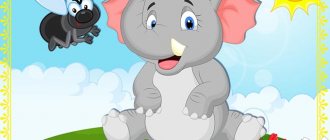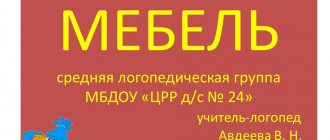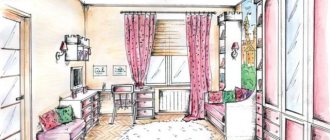Summary of game OD in the senior group of kindergarten on the topic: Furniture
Game educational activities for older preschoolers.
TOPIC: Furniture OBJECTIVES : 1. Learn to identify prefixed verbs in the speech stream, practically use them in speech. 2. Learn to remember and follow complex instructions with prefixed verbs. 3. Continue to work on the formation of dialogical speech. 4. Expand children's vocabulary on the topic. EQUIPMENT: subject pictures on the topic; pictures “hallway, “living room”, “kitchen”, “bedroom”. PROGRESS OF THE LESSON: I. Organizational moment. Children approach the table on which there are pictures depicting pieces of furniture and take turns naming them. - How can you call these objects in one word? - What is furniture for? -Where is she standing? (in a house, apartment). They go to their places. II. Updating knowledge. - I invite you to visit. I open the door and you find yourself where? (picture of the hallway).
- In the hall. — What kind of furniture do we see here? — Hanger, bedside table. — Go to the kitchen (picture of the kitchen). What kind of furniture is there?
— I invite you to the room (picture of the room). What kind of furniture do we see here?
- What kind of sofa? What kind of chair? etc. - Now let’s go to the bedroom (picture of the bedroom).
— What kind of furniture do we see here? Result: - Name the furniture you can sit on. And sleep? What is the table for? How many legs does he have? What kind of furniture is in our group? Office? III. Grammatical categories. Prefix verbs. 1. Memorizing, speaking and following complex instructions with prefixed verbs.
a) Go to the table, walk around the table, move away from the table towards the door.
b) Go out to the bedroom, go to the bed and go to the group. c) Bring a watering can from a corner of nature, bring it to the table, take it to the windowsill. d) Move the watering can from the windowsill to the table, take it out of the group, take it to a corner of nature. 2. Game “On the contrary”
(transformation of prefixed verbs according to the model): - enter the room - leave the room;
- open the door - ..., - go to the table - ..., - come to visit - ..., - drive up to the gate - ..., - bring a toy - ... . 3. Game “Lost Words”
(finishing sentences with prefixed verbs based on plot pictures). - Roma into the house... (enters). - Roma to the house... (approaches). - Roma leaves the house... (comes out).
- Roma pours water into a glass... (pours it). - Rum from glass to glass of water... (overflows).
4.
Game “Correct the mistake”
(consolidating the understanding of prefixed verbs).
— Children are pouring flowers in the flowerbed. — Mom pours soup into a plate. — The cooks pour gravy over the casserole. — Vanya pours water from a watering can. — Tanya pours water into a glass. IV. Summary of the lesson. - What did we talk about today? - Who needs furniture for?
We recommend watching:
Abstract of educational activities in the senior group “Northern Adventures” Synopsis of educational activities in the senior group with a presentation Synopsis of educational activities for children of the senior group in the direction: Moral patriotic education Synopsis of educational activities in the senior group: Birds in winter
Similar articles:
Lesson summary for older preschoolers on the topic: Transport
Developmental lesson in the senior group of preschool educational institutions
Drawing lesson for senior group
Summary of educational activities in the senior speech therapy group on the topic “Construction”
Summary of joint activities of the teacher and children of the senior speech therapy group on the development of fine motor skills of the hands
Notes on cognitive development on the topic Furniture (senior group)
Abstract of educational activities on cognitive development with elements of research activities in the senior group on the topic: “Furniture”
Target:
activating children's knowledge about furniture; the material from which it is made.
Educational objectives:
activate nominative, predicative, attributive vocabulary on the topic “Furniture”. Learn to form and correctly use relative adjectives in speech, practice the formation of the plural form of the nominative case and the genitive case of nouns.
Developmental tasks:
develop the ability to compare, identify characteristics of objects, establish cause-and-effect relationships between objects and materials, generalize and draw conclusions. Develop mental operations of generalization and classification.
Educational tasks:
to develop skills of cooperation, a positive attitude towards participation in joint activities, initiative and independence. Cultivate a caring attitude towards household items
Equipment:
— Cards for the game “Fourth Odd.”
— Illustration “ancient people”.
— For educational and research activities: stones, boards, nails, hammer.
— Scheme: Stone - saw - nail with hammer - plane (all actions are crossed out). Wood - saw - nail with hammer - plane.
— Cut-out pictures (furniture).
— Scheme: one – many – none.
GCD move:
Organizing time.
Hello, golden sun! (Show the sun).
Hello, blue sky!
(Show the sky).
Hello, light breeze!
(Show “breeze”).
Hello, little oak tree!
(Show “oak tree”).
Hello, high chair! (Point to the chair).
Hello, table! (Point to the table).
Hello, guest, you have come to us! (Waving to guests).
Hello, Morning!
(Gesture to the right).
Hello Day!
( Gesture to the left
).
We are not too lazy to say hello!” ( Spread both arms to the sides
).
Main part.
By the time the guests arrived, we had put the family in order, but some items were out of place.
Exercise “4th extra”:
- Look carefully and name the extra object.
- slippers, sneakers, chair, shoes.
- cap, bed, hat, scarf.
- dress, T-shirt, wardrobe, trousers.
- jacket, overalls, coat, chair.
(Put the image of the extra item on the board).
— How can you call all these objects in one word? (Furniture)
Teacher's story, illustration:
— A long time ago, when there were no villages or cities, people lived in caves. To escape the rain and cold, they lit fires and warmed themselves by the fire.
What do you think people used to relax on? (On the grass, on the ground, on the stones).
- Think about whether it was convenient for them or not. Why was it uncomfortable? How did they feel? (Hard, uncomfortable).
The ancient people were uncomfortable, the earth was wet, cold, hard, the stones were sharp.
- If you lie in the cold for a long time, what happens? (You can freeze, catch a cold, get sick).
And then one day, the hunters, returning with their prey, sat down to rest on a fallen tree. Imagine that you are in the forest, sitting on a tree. Comfortable? Better than on earth?
It was then that the man began to think, what should he make furniture from? There were only rocks and trees around the cave.
- Let's examine and compare stones and wood (touch it, put it on your cheek, smell it).
Research activities.
- Touch the stone, tell us about it (hard, cold, heavy, uneven, rough, strong).
—
Touch the wood, tell us about it (
it’s pleasant to the touch, warm, strong, you can plan it and it will become smooth, you can drive a nail into it well, you can drill holes in it).
— Tell me, can a stone be cut? (No)
—Can you hammer a nail into a stone? (No)
—Can the stone be cut? (No)
— Let’s denote all these actions with the following diagram. (Show diagram)
—Can the tree be cut?
—Can you hammer a nail into a tree?
—Can the tree be cut?
— Let’s denote actions with a tree as follows. (Show diagram)
— Look at the diagrams and tell me, what is easier to make furniture from? Why?
Conclusion
: A person chose wood to make furniture because it is pleasant to the touch and can be processed well.
Later, furniture began to be made from other materials.
Exercise “What is furniture made of?” (in a circle)
wooden furniture – what kind? (wooden)
made of metal - which one? (metal)
made of plastic - which one? (plastic)
made of glass - which one? (glass)
We remembered what furniture is made of, and now we’ll build it ourselves.
Finger game "Furniture"
This is a chair - they sit on it ( the left palm in a fist is pressed against the right, fingers extended upward
).
This is a table - people sit at it ( the left hand is in a fist, the right open palm lies on top
)
Here is a bed - they are lying on it ( arms bent at the elbows in front of the chest, lying one on top of the other
)
We put things away in the closet ( imitation of folding things
)
We all go for a walk ( the fingers of both hands walk on the knees
)
In order for furniture to last longer, you need to take care of the furniture.
.
- How should this be done? (Wipe, wash, clean, repair, vacuum, knock out).
Cut pictures
(of four parts). Exercise “Name the parts of an object.”
Collect furniture items.
- What happened? (I got a chair, a wardrobe, an armchair)
- Name the parts of a chair, cabinet, armchair.
Game "One, many, no."
Talk about your subject using a diagram. (One - many - no).
Reflection.
— What do you remember most?
— What furniture would you choose for your apartment? Why?
— What did you especially like?






